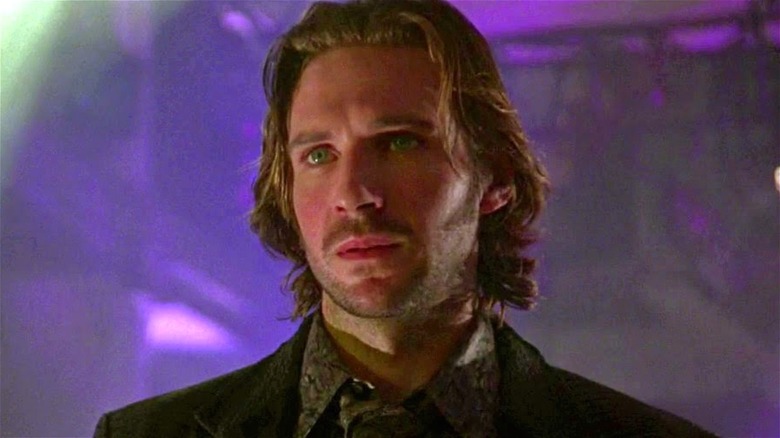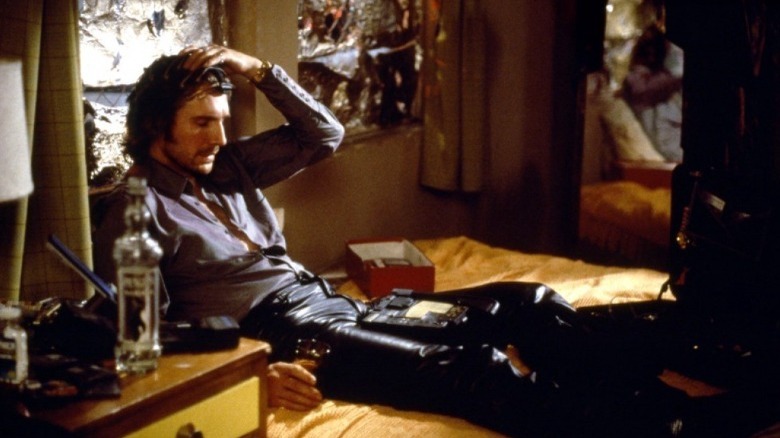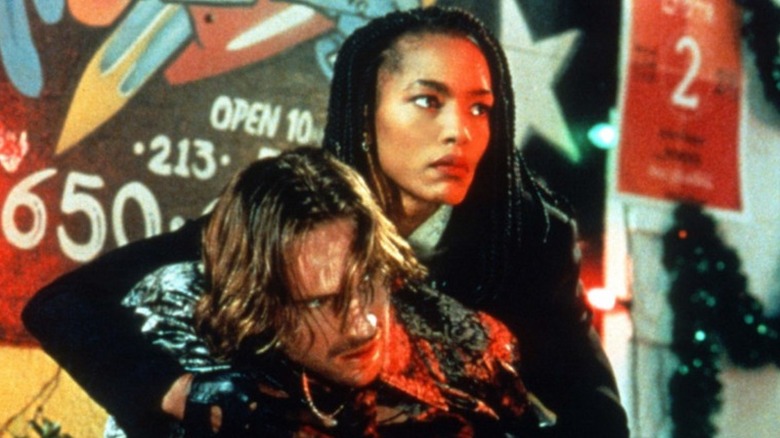The Opening Of Kathryn Bigelow's Strange Days Took Six Months To Set Up, With The Help Of James Cameron
When director Kathryn Bigelow's "Strange Days" hit theaters in 1995, the film was marketed as a cyberpunk tech-noir thriller set in the year 1999, right at the cusp of the millennium. Although "Strange Days" delivered significantly more than it promised, the film was a box-office dud and received incredibly mixed reviews from critics — a combination that nearly derailed Bigelow's career. Apart from directing, Bigelow honed in on the gritty socio political themes that run through the film, including a scathing commentary on racial violence and police brutality. However, the core premise of "Strange Days" was conceived by James Cameron, who had co-written the script with Jay Cocks and supervised the film's complex technical aspects.
Cameron, who is known for his exhaustive dedication to polishing the visual language of a film, personally oversaw the brilliant three-and-a-half-minute POV opening shot that mimics a one-shot take. The technical prowess of the scene aside, which took six months to set up and required multifaceted camera rigs, the opening offers a one-of-a-kind visceral experience by placing the viewer in the driver's seat. The POV shot is that of a robber, who chills in the back of a car with his partner, and loads a gun while donning a mesh mask. The robber, and by extension, the viewer, busts into a Chinese restaurant, terrorizes the patrons and robs the cash register. After the police arrive, we get a frantic, exhilarating POV of the escape — there's some mid-level rooftop parkour — until the robber falls to his death.
How did Cameron and his team manage to capture the mechanics of this immersive, voyeuristic experience, which functions both as a memory and a sensory recording? Here's a look into the grunge futurism of "Strange Days," and how its essence was captured in the film's seedy, borderline snuff film-like aesthetic.
'You ready? Boot it'
In Brent Dunham's "Conversations with Filmmakers" book-series, which includes interviews with Cameron, the director explained how he captured the "sensorily-complete reality" of "Strange Days" on the big screen. As the film switches between objective and subjective POVs, the scenes featuring the latter had to be laced with a grain-heavy, aesthetically jarring quality. Taking the example of the opening scene, Cameron talked about the mechanics of making it look like a subjective one-shot that captures the visceral nature of the final minutes:
"It's one POV; all the actors play directly to the camera, in effect directly to the audience, meaning the person that is wearing the rig...you run across the roof, the guy ahead of you makes the jump, you hear your own breathing and heartbeat, he's screaming, the cops are running toward you, you run, you don't make it, you grab onto the other side of the wall, you look down, your feet are trying to climb but can't get up the wall, the guy's pulling you up, he gets shot and you fall all the way to the alley, six stories down, you hit the ground and the screen goes black."
Cameron's attention to detail while describing this scene is vital, as every sonic and visual layer intensifies Lenny's (Ralph Fiennes) SQUID experience. The sensations/emotions felt by the robber before his final moments are directly felt by the user via SQUID, which makes the seemingly one-shot nature of the scene critical to the VR experience. Bigelow, Cameron, and their ream planned these choreographed elements for six months and special cameras and rigs had to be set up for the rooftop scene in particular. Although there were several cuts throughout, transitions were deftly used to make it look like a seamless amateur recording of a robbery gone wrong.
The strange, nightmarish visuals of Strange Days
Over the years, "Strange Days" has (rightfully) undergone critical reappraisal, with the film being hailed as an important piece of cyberpunk media that tackles technological voyeurism. The narrative aspects of the film might still elicit mixed reactions: although Bigelow's vision is a sharp, uncompromising one, I feel that the film suffers from an overabundance of undercooked threads. There is a lot going on, and Bigelow has a lot to say about gendered and racial violence, but the sharper edges of her commentary become dull when it is busy exploring too many side plots.
However, what does stand out is the film's unique visual language, which oscillates between mildly disorienting VRs to disturbingly violent POVs that feel a little too real. Despite dealing with a range of settings and switching between POVs, the film's tone is consistently paranoid and chaos-riddled, all for a good reason. This is a world that is seemingly on the brink of extinction, as the end of the millennium evokes a deeply-unsettling apocalyptic quality. Technology is a drug sought after for thrills or escapism, the streets are rife with riots after a Black activist is shot in cold blood, and a rapist runs around shooting POVs while he assaults and kills women. "Strange Days" uses its visual fabric to highlight these strands without compromise, and the result is an immersive roller-coaster that makes you feel slightly sick to the stomach.
However, there's a silver lining in this otherwise bleak experience. "Strange Days" adamantly ends on a note of hope and the promise of a new beginning, despite the darkness that hounds the characters throughout. Interestingly, we buy into this hope eagerly, deciding to put faith in humanity's redeeming traits, for better or for worse. Now, that is powerful filmmaking.


